Updated on July 23, 2024
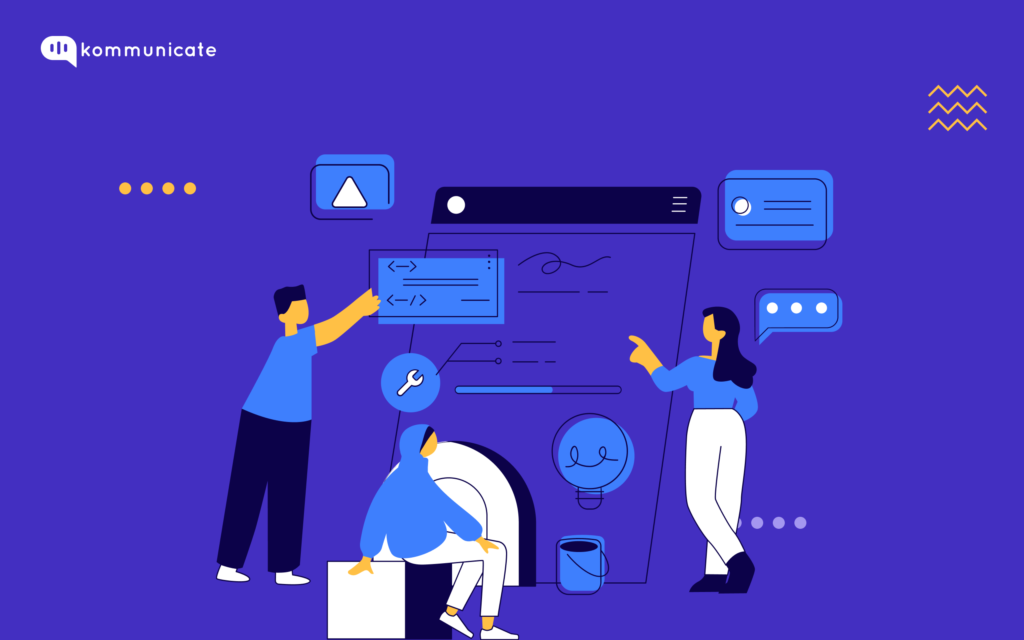
Businesses today are constantly seeking innovative ways to drive product adoption, enhance engagement, and foster long-term retention of their customers.
The primary reason behind this is the fierce competition in the market and the ever-evolving landscape of consumer preferences and behaviors – to stay relevant in such an environment, it is imperative that the business continuously innovate and leverage technology to deliver exceptional experiences for their customers and win them for life.
One such technology that has gained significant momentum in the last few years is chatbots!
Generative AI Chatbots are playing a major role in the entire lifecycle of a customer with a product – right from the initial interaction with a brand to post-purchase support and beyond. They have transformed the way customers interact with a brand today and have revolutionized customer service standards across industries.
For companies pursuing a product-led growth model, chatbots become all the more important to drive customer engagement and retention. In this blog, we will dive deeper into what Product-led growth is and how chatbots can be leveraged to drive successful customer adoption.
Here’s a quick snippet of what is covered –
- What is Product-Led Growth – Difference between PLG and other Growth Strategies
- Product Adoption, Engagement and Retention – Why do they matter in a PLG
- Product Adoption – What is it and how chatbots can help.
- Chatbots and the role they play in Product Engagement.
- Product Retention – Essentials and the role of chatbots in it
What is Product- Led Growth?
Product-Led Growth, or PLG, is a relatively new strategy that B2B and SaaS companies use to achieve growth. PLG is when a company’s product is the primary method for customer acquisition, retention and expansion.
PLG is based on the foundational principle that a product is so good, that there is not a lot of requirement of sales or marketing to drive its growth.
Companies like Zoom and Dropbox have been using the PLG approach to phenomenal success.

So, why Product-Led Growth? What’s the Difference between Product-led growth and Sales led and Marketing-led growth?
We have scratched the surface of what Product-led growth is. So Why PLG?
With PLG, your product will drive a majority of user acquisition, which means the cost spent on traditional marketing or sales is reduced. Also, if you offer a good product experience, your customers are more likely to recommend it to their friends and family, which gives a further boost to your brand.
Now, let us see the difference between Product-led growth, compared to the traditional sales led and marketing led growth.
Product-led growth: The focus here is on building a great product that the users will fall in love with. The product will drive customer adoption. These companies may also employ sales and marketing functions, but they may not be the primary driver of growth.
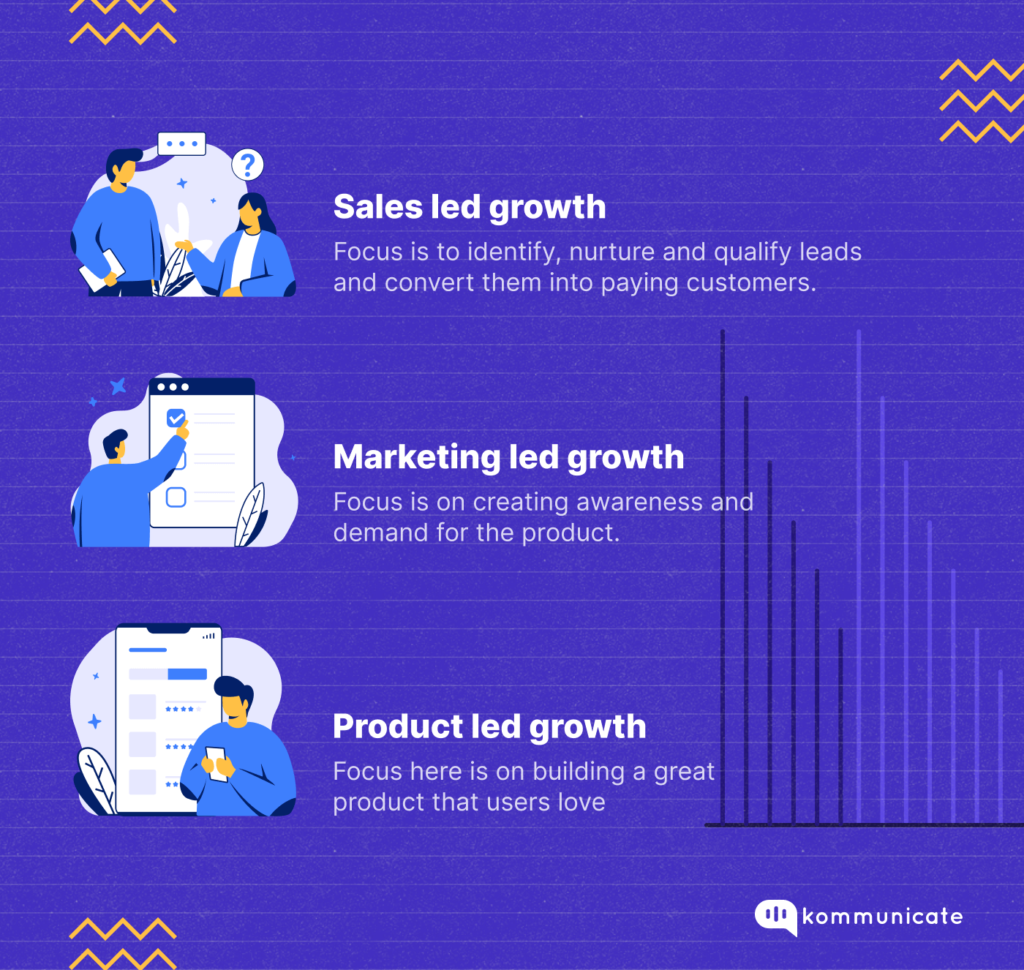
When it comes to Sales Led and Marketing Led Growth strategies, the acquisition of new customers is through sales or marketing efforts respectively. These companies may have dedicated sales or marketing teams, who drive growth.
Product Adoption, Engagement and Retention – Why do they matter in a PLG?
In any business that uses the PLG model, product adoption, engagement and retention are all key metrics that you need to track.
Product adoption is getting users to start using your product. Making them keep using the product on a regular basis is product engagement. Product retention is when they keep using your product over a set period of time.
Sustainability and Scalability are the two hallmarks of a successful growth engine, especially in a PLG company. When these companies focus on Product Adoption, Engagement and Retention, they are addressing these very 2 pillars.
Product adoption, engagement and retention are all interrelated. For instance, if a user does not adopt your product, it is not possible for them to engage with it. Similarly, if you do not keep your customers engaged, there is no way you can retain them for the long run.
Technology comes to the rescue when it comes to driving these 3 metrics, specifically chatbots. Chatbots can drive product adoption by offering personalized recommendations and answering questions related to onboarding. Chatbots can also encourage users to try the product before they buy.
When it comes to product engagement, chatbots can help in real – time assistance and troubleshooting. Chatbots can also gamify the process and also offer rewards to existing customers. And finally, chatbots can help retain existing customers by offering them exclusive content and up-selling and cross-selling your services.
Let’s explore all of these aspects in detail.
Product Adoption – What is it and Why it Matters.
When you build a product or a service and the customer uses it for its intended purpose, then this stage of the product’s cycle is called product adoption. Product adoption can also be when a certain percentage of first-time users perform an intended action.
We have talked about awareness before, so how different is it from adoption? Well, for starters, if people do not know about your product or service ( say, an eCommerce website) and then you make them aware, that is the end of the awareness stage.
But when these website visitors turn into paid users, then that is the completion of an intended action. That stage is called product adoption.
Product adoption helps you answer some very important questions, such as:
- How sticky is my product to new users?
- Which channels should I spend a majority of my advertising budget on?
- How are your retention rate and the speed of adoption related?
Metrics such as conversion rate, Time to value and Frequency of purchases all help you drive product adoption. So where do chatbots come into the picture?
How can chatbots drive Product Adoption?
Chatbots can be crucial in driving Product Adoption, and some of the ways chatbots can drive it are:
1. Personalized recommendations:
Chatbots can collect user data easily, which companies can then use to make informed decisions. For example, if you are an eCommerce website, a chatbot can recommend products when a visitor is browsing a particular category of products or when they are about to abandon their cart.
Chatbots can also collect data about what users interests, including the articles that they have read or products they have viewed. With this data, your company can create personalized recommendations for products or services that the user is most likely to purchase.
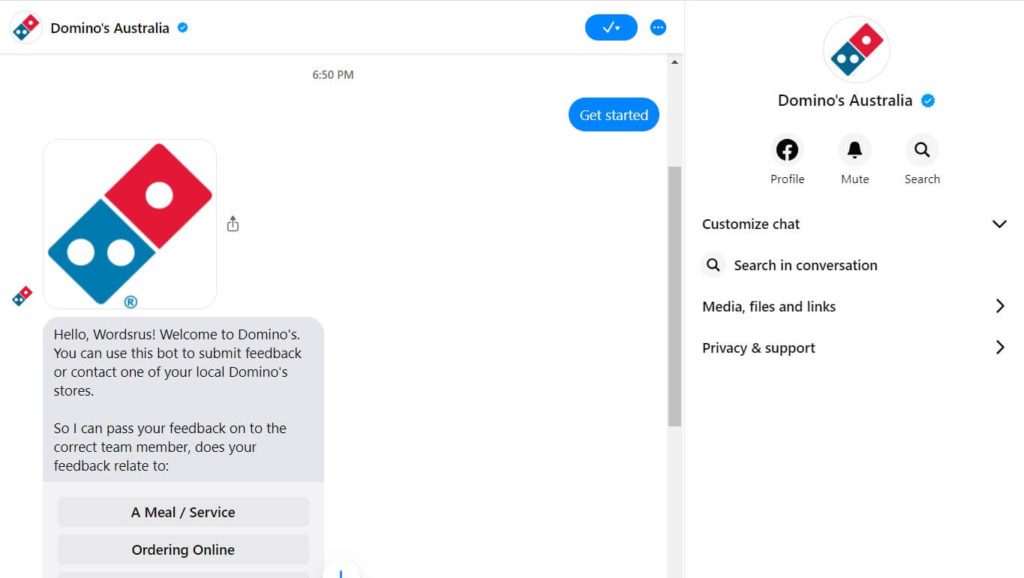
Domino’s did a great job when they implemented an eCommerce chatbot for their Australian market. The chatbot was able to collect orders online. The chatbot was able to re-order a member’s previous orders, and track a user’s order and estimated time of delivery.
2. On boarding assistance.
Chatbots can provide swift responses to customers who may have queries regarding a product, the major features and how to use it. Once the users have this information handy, they can get up and running quickly.
Chatbots can act as virtual guides, walking the users through product features and helping users troubleshoot the problems. For instance, in a clothing eCommerce store, a chatbot can show all the brands of clothes available with their price range, and a user can choose right from within the bot.
All this without navigating through different pages, now that is called enhancing user experience!!
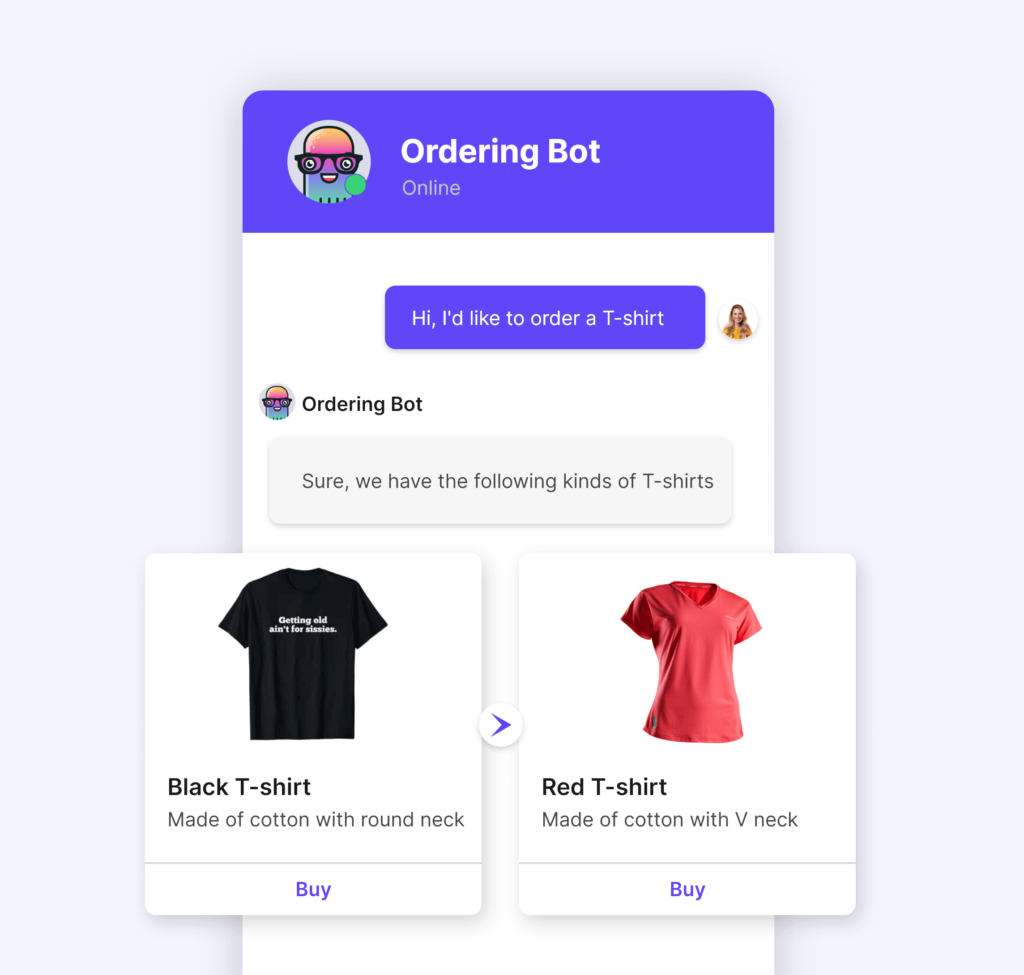
The 24/7 availability of chatbots means that user onboarding can be done at any time of the day or night. This is especially helpful for customers who live in a different country or time zone, or work odd hours.
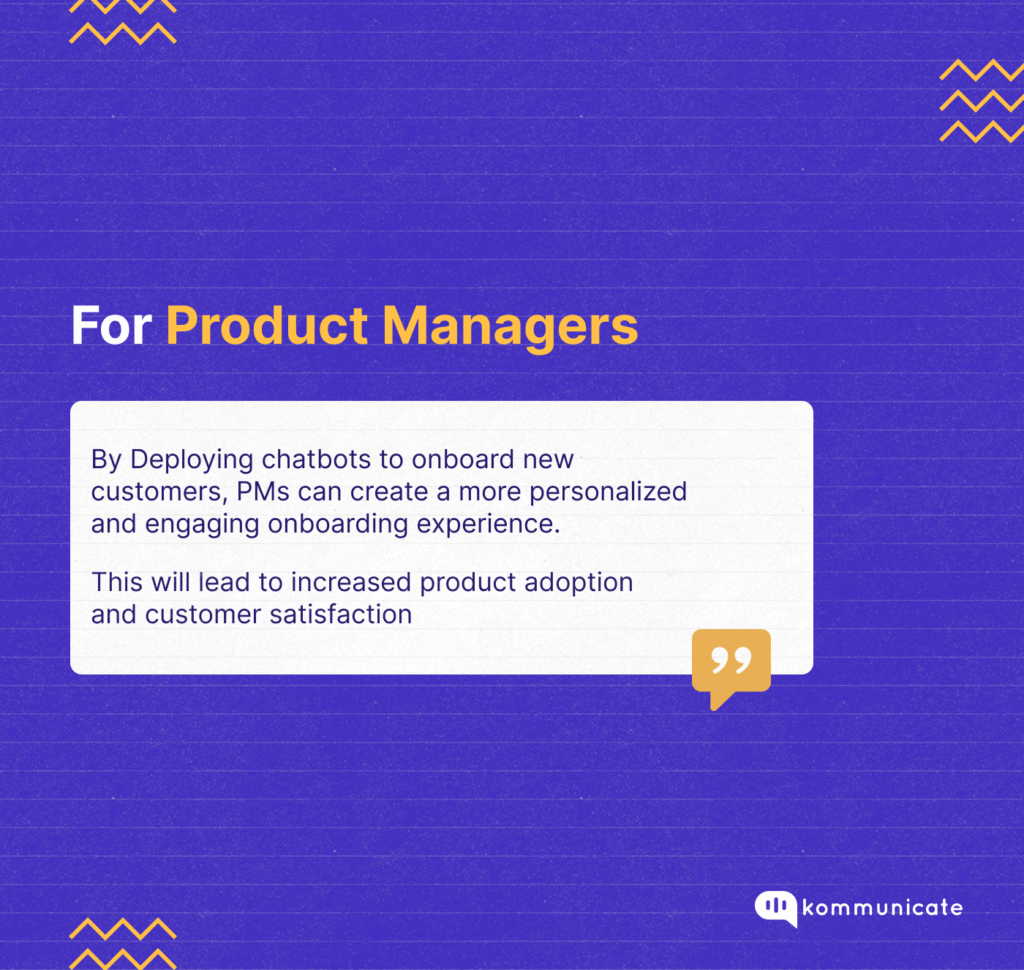
3. Encouraging Trial and Purchase
In case a customer is in two minds with regards to buying a product, a chatbot can offer a free trial of the product, thereby increasing chances of conversion. “Try before you buy” is an adage that we use in the SaaS industry, and you can use a chatbot to initiate a free trial.
Additionally, chatbots can offer coupons and discounts to customers who are planning to make a purchase. Making the product more affordable and encouraging customers to invest in you, means your implementation of the chatbot was a success.
Many times, chatbots act as an additional FAQ base, where customers can ask common questions without having to navigate through the website to find the FAQ section. With Kommunicate’s Document scanner feature, creating an FAQ chatbot becomes even more simpler.
Finally, chatbots can give social proof to users by displaying testimonials of happy customers. This can help build credibility and trust with the customer, who will then most likely make a purchase.
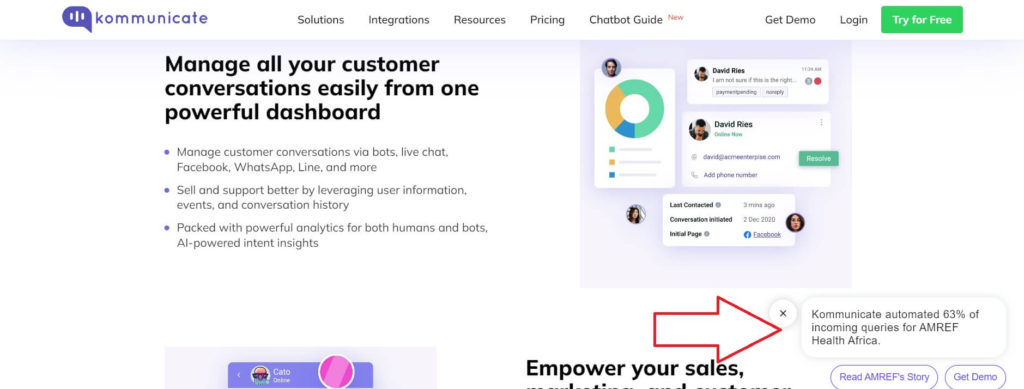
Product Engagement – What is it?
We have written in detail about product engagement here, but a quick refresher never hurts anyone. Product engagement is a measure of how your intended users interact with your product.
Product engagement helps answer critical questions such as:
- How often do my customers use my product?
- Where are they usually stuck while using your product?
- Which part of my product is the most popular / the users find the most value in?
Metrics such as User Retention Rate, Active User Count, Session length, etc. will all tell you how effective your product engagement strategy is.
So now, let us see how chatbots play a pivotal role in driving product engagement.
Chatbots and the role they play in Product Engagement
1. Real-time assistance and troubleshooting
Chatbots can provide answers to questions about the product, about the various features that the product has to offer, and how to use it. Customers don’t want to wait for days to get answers to their queries, and a chatbot will be there for them even when a customer support agent isn’t.
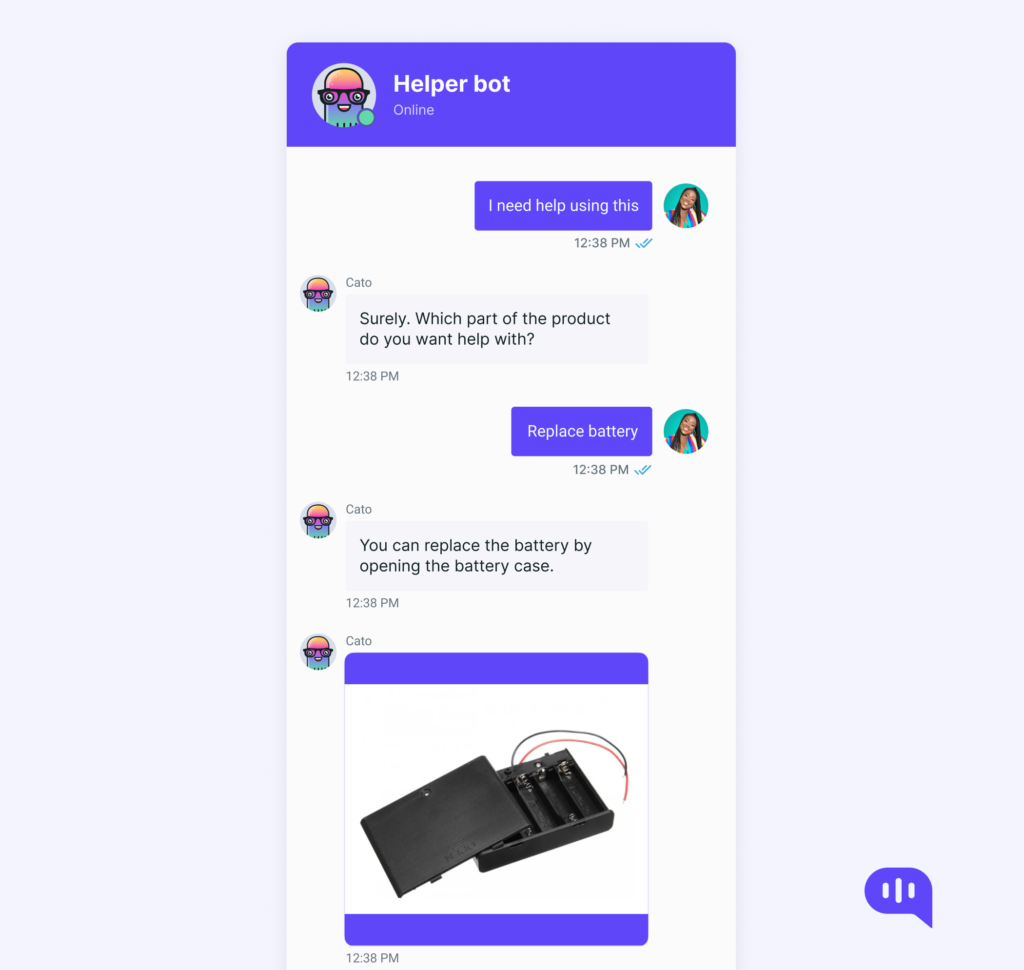
Troubleshooting of queries is another aspect that chatbots can help in. Chatbots can provide users with tips and tricks on how to use the product, along with redirecting them to specific sections of the website which contain documentation.
2. Offering rewards
We have seen how chatbots can be used to drive personalization at scale. Another area that we find the application of chatbots is in offering personalized rewards, which is based on their interests and behavior. Relevant rewards means that there is a greater chance of the user taking action.
Engaging customers can be taken to a whole new level using chatbots, when you use them to offer rewards in real-time. This can be when a user has completed a certain task or achieved a goal. This comes under the broad category of gamification, which we will cover later.
3. Interactive UX and Gamification
Here are a few ways how chatbots can help in enhancing the User experience during a Digital User Journey, which in turn will help foster product engagement.
- Progress tracking: Chatbots can keep users motivated by highlighting the major achievements and milestones.
- Gripping interactions: Chatbots mimic human behavior, and can guide users through a product in a conversational manner.
- Gamification: “ Learning through play,” the process of making the learning about the product enjoyable through quizzes, can be done using chatbots.
- Continuous engagement: When people interact with your chatbot regularly, it piques their interest. This helps boost user engagement and reinforces their journey.
Product Retention – What is it and why it matters
When your existing customers continue to buy from your business, then your product retention strategy is working. Some people call it “Customer loyalty,” as well.
You can measure product retention when you answer questions such as:
- What share of your customers buy more than once from you?
- What is the average value of a repeat customer’s order?
- How often do they purchase from you?
Retention matters because a business with a large customer retention rate does not lose a lot of them to the competition. Nor do they get obsolete when a radical new technology is introduced in their space.
Let us now see how chatbots can help drive Product retention.

Product Retention – Essentials and the role of Chatbots
Retention is an important step in the Digital User Journey, and companies that use a PLG model for growth usually focus a lot of their energies in this stage.
Here are a few ways chatbots are helping companies in the retention phase.
1. Offering exclusive content:
Chatbots can offer existing customers early bird access to content, giving them a feeling of exclusivity. For instance, on our own Kommunicate blog, we have deployed a separate chatbot called Adam.
Adam gives visitors to the blog access to new blogs, and also allows them to search various topics that interests them. This helps us retain visitors to the blog, and, after implementing Adam, we have seen a 32% bump in readership.
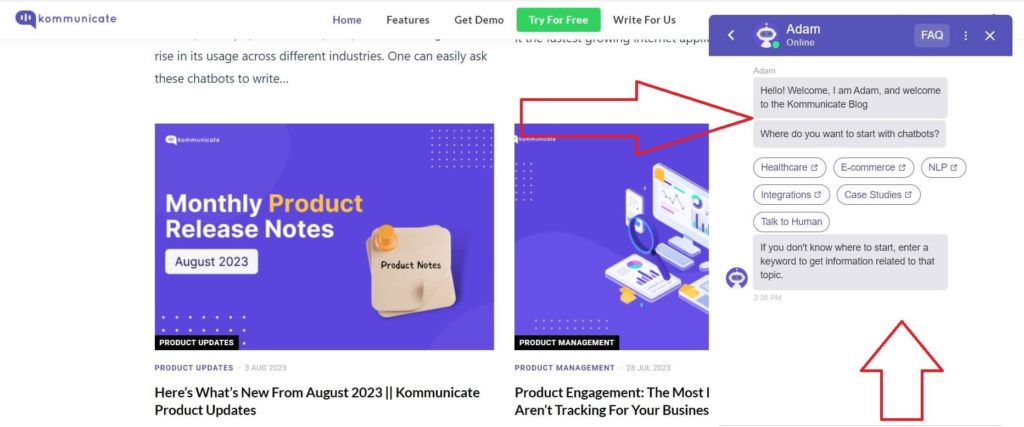
2. Up-sell and cross-sell products
You can use chatbots to up-sell and cross-sell products if you are running an online store. Getting a visitor to your website is very difficult, as any website owner knows. In fact, the average visitor only spends only about 54 seconds on your website, according to this report from ContentSquare.
To make the most of your website visitors, it is important to keep offering them a collection of products that they are most likely to purchase. This is where chatbots can step in. Chatbots can collect important information about users and then use that information to suggest products that they are most likely to buy.
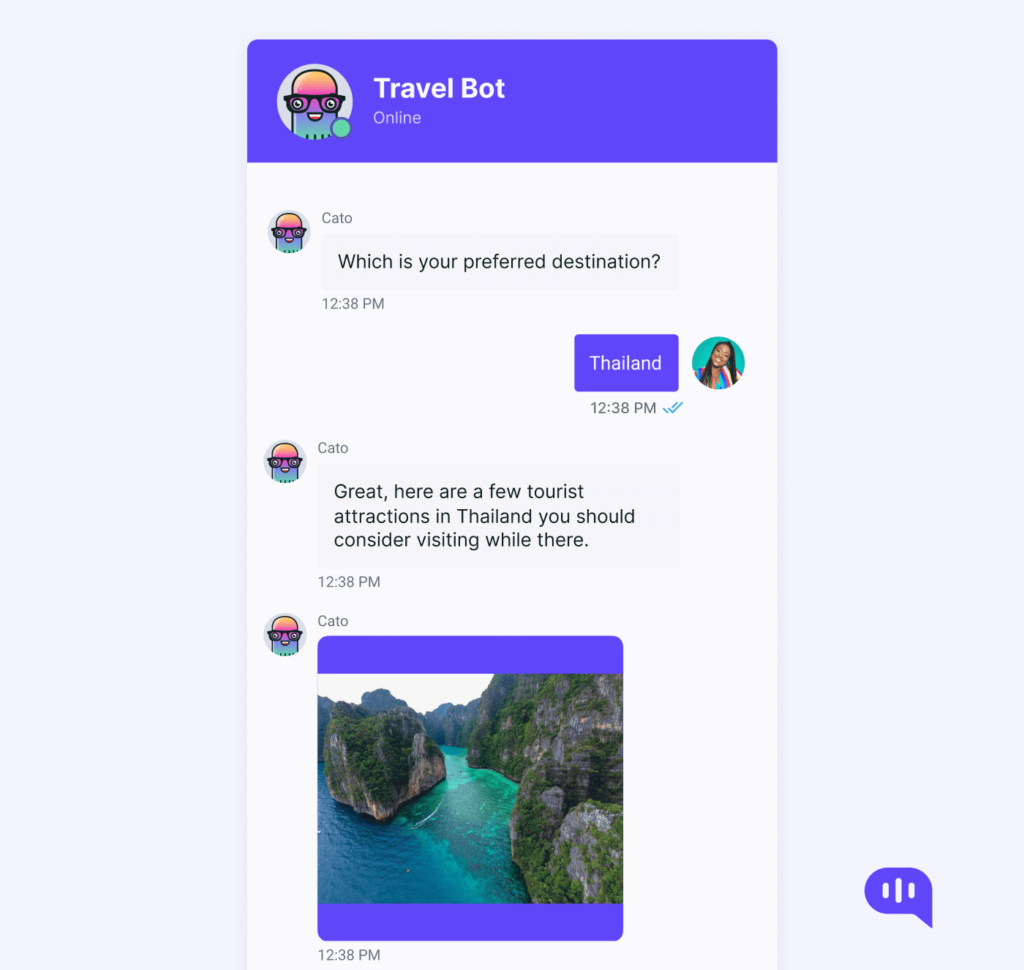
Up-selling and Cross- selling can thus enhance your business and help you achieve your business objectives through unconventional channels.
3. Garnering positive reviews
Your website visitors are humans too, and every now and then, they would like to leave an honest feedback about their experience. Chatbots to the rescue – again. Before a customer leaves your website, you can prompt them to leave a review about your product, right within the chatbot.
This will give your customers a reason to be loyal to your brand. You can use the positive feedback as testimonials on your website, which can act as powerful social proof.
Major takeaways:
Thanks for reading this far. Here are the key takeaways from this blog post:
- With PLG, your product will drive a majority of user acquisition, which means the cost spent on traditional marketing or sales is less.
- Understanding the Digital User Journey is critical to create a product that users will fall in love with, while also meeting their needs.
- Deploying chatbots to onboard new customers will lead to increased user adoption and satisfaction.
At Kommunicate, we envision a world-beating customer support solution to empower the new era of customer support. We would love to have you on board to have a first-hand experience of Kommunicate. You can signup here and start delighting your customers right away.

CEO & Co-Founder of Kommunicate, with 15+ years of experience in building exceptional AI and chat-based products. Believes the future is human + bot working together and complementing each other.






